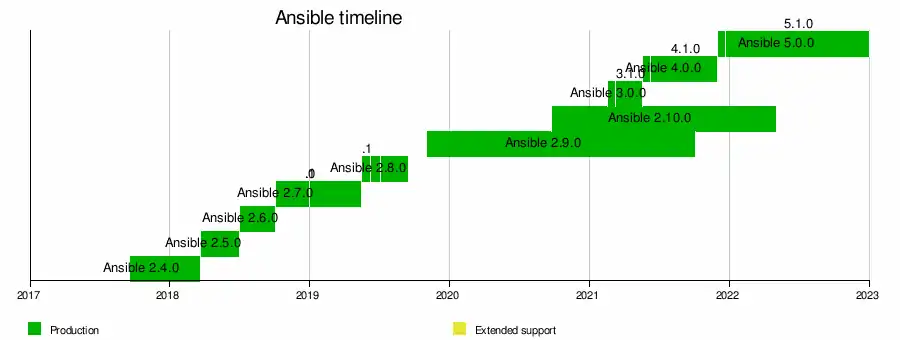 | |
| Original author(s) | Michael DeHaan |
|---|---|
| Developer(s) | Ansible Community / Ansible Inc. / Red Hat Inc. |
| Initial release | February 20, 2012 |
| Stable release | |
| Repository | |
| Written in | Python, PowerShell, Shell |
| Operating system | Linux, Unix-like, MacOS, Windows |
| Available in | English |
| Type | Configuration management, infrastructure as code (IaC), Orchestration engine |
| License | GNU General Public License version 3 |
| Website | www |
Ansible is a suite of software tools that enables infrastructure as code. It is open-source and the suite includes software provisioning, configuration management, and application deployment functionality.[2]
Originally written by Michael DeHaan in 2012, and acquired by Red Hat in 2015, Ansible is designed to configure both Unix-like systems and Microsoft Windows. Ansible is agentless, relying on temporary remote connections via SSH or Windows Remote Management which allows PowerShell execution. The Ansible control node runs on most Unix-like systems that are able to run Python, including Windows with Windows Subsystem for Linux installed.[3] System configuration is defined in part by using its own declarative language.
History
The term "ansible" was coined by Ursula K. Le Guin in her 1966 novel Rocannon's World,[4] and refers to fictional instantaneous communication systems.[5][6]
The Ansible tool was developed by Michael DeHaan, the author of the provisioning server application Cobbler and co-author of the Fedora Unified Network Controller (Func) framework for remote administration.[7]
Ansible, Inc. (originally AnsibleWorks, Inc.) was the company founded in 2013 by DeHaan, Timothy Gerla, and Saïd Ziouani to commercially support and sponsor Ansible.[8][9][10] Red Hat acquired Ansible in October 2015.[11][12]
Ansible is included as part of the Fedora distribution of Linux, owned by Red Hat, and is also available for Red Hat Enterprise Linux, CentOS, openSUSE, SUSE Linux Enterprise, Debian, Ubuntu, Scientific Linux, and Oracle Linux via Extra Packages for Enterprise Linux, as well as for other operating systems.[13]

Architecture
Overview
Ansible helps to manage multiple machines by selecting portions of Ansible's inventory stored in simple plain text files. The inventory is configurable, and target machine inventory can be sourced dynamically or from cloud-based sources in different formats (YAML, INI).[14]
Sensitive data can be stored in encrypted files using Ansible Vault[15] since 2014.[16] In contrast with other popular configuration-management software — such as Chef, Puppet, Salt and CFEngine — Ansible uses an agentless architecture,[17] with Ansible software not normally running or even installed on the controlled node.[17] Instead, Ansible orchestrates a node by installing and running modules on the node temporarily via SSH. For the duration of an orchestration task, a process running the module communicates with the controlling machine with a JSON-based protocol via its standard input and output.[18] When Ansible is not managing a node, it does not consume resources on the node because no daemons are run or software installed.[17]
Dependencies
Ansible requires Python to be installed on all managing machines, including pip package manager along with configuration-management software and its dependent packages. Managed network devices require no extra dependencies and are agentless.[19]
Control node
The control node (master host) is intended to manage (orchestrate) target machines (nodes termed as "inventory", see below).[20] Control nodes can be run from Linux and Unix-like operating systems (including MacOS); Windows OSs are only supported through the Windows Subsystem for Linux.[21] Multiple control nodes are allowed.[20] Ansible does not require a single controlling machine for orchestration,[22] ensuring that disaster recovery is simple.[22] Nodes are managed by the controlling node over SSH.
Design goals
The design goals of Ansible include:[18]
- Minimal in nature. Management systems should not impose additional dependencies on the environment.[17]
- Consistent. With Ansible, one should be able to create consistent environments.
- Secure. Ansible does not deploy agents to nodes. Only OpenSSH and Python are required on the managed nodes.[17][22]
- Reliable. When carefully written, an Ansible playbook can be idempotent, to prevent unexpected side effects on the managed systems.[23] It is possible to write playbooks that are not idempotent.
- Minimal learning required. Playbooks use an easy and descriptive language based on YAML and Jinja templates.
Modules
Modules[24] are mostly standalone and can be written in a standard scripting language (such as Python, Perl, Ruby, Bash, etc.). One of the guiding goals of modules is idempotency, which means that even if an operation is repeated multiple times (e.g., upon recovery from an outage), it will always place the system into the same state.[18]
Inventory configuration
Location of target nodes is specified through inventory configuration lists (INI or YAML formatted) located at /etc/ansible/hosts (on Linux).[14][25] The configuration file lists either the IP address or hostname of each node that is accessible by Ansible. In addition, nodes can be assigned to groups.[14]
An example inventory format (INI file):
192.168.6.1
[webservers]
foo.example.com
bar.example.com
This configuration file specifies three nodes: the first node is specified by an IP address, and the latter two nodes are specified by hostnames. Additionally, the latter two nodes are grouped under the webservers group.
Ansible can also use a custom Dynamic Inventory script, which can dynamically pull data from a different system,[26] and supports groups of groups.[27]
Playbooks
Playbooks are YAML files that store lists of tasks for repeated[28][20] executions on managed nodes.[20][29] Each Playbook maps (associates) a group of hosts to a set of roles. Each role is represented by calls to Ansible tasks.[30]
Ansible Automation Platform
The Ansible Automation Platform (AAP) is a REST API, web service, and web-based interface (application) designed to make Ansible more accessible to people with a wide range of IT skillsets. It is a platform composed of multiple components including developer tooling, an operations interface, as well as an Automation Mesh to enable automation tasks at scale across data centers. AAP is a commercial product supported by Red Hat, Inc. but derived 17+ upstream open source projects including the AWX upstream project (formerly Ansible Tower derived from), which has been open source since September 2017.[31][32][33][34]
There also is another open source alternative to Tower, Semaphore, written in Go.[35][36]
Platform support
Control machines have to be a Linux/Unix host (for example BSD, CentOS, Debian, macOS, Red Hat Enterprise Linux, SUSE Linux Enterprise, Ubuntu[13]), and Python 2.7 or 3.5 is required.[19]
Managed nodes, if they are Unix-like, must have Python 2.4 or later. For managed nodes with Python 2.5 or earlier, the python-simplejson package is also required.[37] Since version 1.7, Ansible can also manage Windows[38] nodes.[37] In this case, native PowerShell remoting supported by the WS-Management protocol is used instead of SSH.
Ansible can deploy to bare metal hosts, virtual machines, and cloud environments.[18]
AnsibleFest
AnsibleFest is an annual conference of the Ansible community of users, contributors, etc.[39]
| Year | Location |
|---|---|
| 2014 | San Francisco, California, US |
| 2015 | London, UK |
| 2016 | London, UK |
| 2016 | San Francisco, California, US |
| 2016 | Brooklyn, New York, US |
| 2017 | London, UK |
| 2017 | San Francisco, California, US |
| 2018 | Austin, Texas, US |
| 2019 | Atlanta, Georgia, US |
| 2020 | Virtual only due to COVID-19 pandemic |
| 2021 | Virtual only due to COVID-19 pandemic |
| 2022 | Chicago, Illinois, US |
| 2023 | Boston, Massachusetts, US |
See also
References
- ↑ "Release 2.16.2". 11 December 2023. Retrieved 19 December 2023.
- ↑ Staff writer. "Overview – How Ansible Works". ansible.com. Red Hat, Inc. p. 1. Retrieved December 7, 2016.
- ↑ "Ansible Documentation-Installation Guide". docs.ansible.com. Retrieved July 7, 2022.
- ↑ Bernardo, Susan; Murphy, Graham J (2006). Ursula K. Le Guin : a critical companion. Westport, Conn: Greenwood Press. p. 18. ISBN 978-0-313-02730-7. OCLC 230345464.
- ↑ "Frequently Asked Questions". docs.ansible.com. Ansible Documentation. Red Hat, Inc. p. 1. Retrieved March 7, 2023.
- ↑ DeHaan, Michael (January 29, 2014). "Google Groups Post – Ansible Project". groups.google.com. p. 1. Retrieved April 26, 2017.
- ↑ Maughan, Mike (April 17, 2012). "An Interview with Ansible Author Michael DeHaan". coloandcloud.com. Maughansem LLC. p. 1. Archived from the original on November 14, 2012. Retrieved November 5, 2012.
- ↑ "About Ansible". Ansible, Inc. p. 1. Archived from the original on September 5, 2015. Retrieved July 8, 2016.
- ↑ Bloomberg Research. "Ansible, Inc.: Private Company Information". Internet Software and Services. Bloomberg L.P. p. 1. Retrieved July 8, 2016.
- ↑ "About Team". 2015-09-05. Archived from the original on 2015-09-05. Retrieved 2021-04-07.
- ↑ Novet, Jordan (October 15, 2015). "Source: Red Hat is buying Ansible for more than $100M". venturebeat.com. VentureBeat, Inc. p. 1. Retrieved October 16, 2015.
- ↑ Staff writer (October 16, 2015). "Red Hat to Acquire IT Automation and DevOps Leader Ansible". redhat.com. Red Hat, Inc. Retrieved October 16, 2015.
- 1 2 Ulianytskyi, Mykola. "ansible Download (DEB, RPM, TGZ, TXZ, XZ)". pkgs.org. Linux Packages Search. p. 1. Retrieved November 5, 2012.
- 1 2 3 "Inventory". docs.ansible.com. Ansible Documentation. Red Hat, Inc. p. 1. Retrieved March 7, 2023.
- ↑ "Ansible Vault — Ansible Documentation". docs.ansible.com.
- ↑ "Ansible vault: a framework for encrypting any playbook or var file. · ansible/ansible@427b8dc". GitHub.
- 1 2 3 4 5 "The Benefits of Agentless Architecture" (PDF). Red Hat, Inc. p. 5.
- 1 2 3 4 "Ansible in Depth" (PDF). Red Hat, Inc. p. 5.
- 1 2 "Python 3 Support". docs.ansible.com. Ansible Documentation. Red Hat, Inc. p. 1. Archived from the original on July 10, 2017. Retrieved July 6, 2017.
- 1 2 3 4 "Ansible concepts — Ansible Documentation". docs.ansible.com. Retrieved 2021-11-19.
- ↑ "Installing Ansible". docs.ansible.com. Retrieved 2023-01-04.
- 1 2 3 "Installation Guide — Ansible Documentation". docs.ansible.com. Retrieved 2018-11-30.
- ↑ "Achieving Rolling Updates and Continuous Deployment with Zero Downtime" (PDF). Red Hat, Inc. p. 7.
- ↑ "Module Index — Ansible Documentation". docs.ansible.com.
- ↑ "Working with Inventory — Ansible Documentation". docs.ansible.com. Retrieved 2018-11-30.
- ↑ "Dynamic Inventory". docs.ansible.com. Ansible Documentation. Red Hat, Inc. p. 1. Archived from the original on August 5, 2019. Retrieved November 25, 2016.
- ↑ "How to build your inventory — Ansible Documentation". docs.ansible.com.
- ↑ "Playbooks". docs.ansible.com. Ansible Documentation. Red Hat, Inc. p. 1. Retrieved March 7, 2023.
- ↑ "Intro to playbooks — Ansible Documentation". docs.ansible.com. Retrieved 2021-11-19.
- ↑ "Task And Handler Organization For A Role". docs.ansible.com. Ansible Documentation. Red Hat, Inc. p. 1. Archived from the original on July 17, 2017. Retrieved November 25, 2016.
- ↑ Redditors (February 19, 2016). "Ansible announces Tower to be Open Source in the near future on AnsibleFest!". reddit.com. Reddit. p. 1. Retrieved July 20, 2017.
- ↑ Staff writer. "The Open Tower Project". ansible.com/open-tower. Red Hat, Inc. p. 1. Retrieved January 21, 2017.
- ↑ Hat, Ansible, Red. "AWX Project FAQ | Ansible.com". www.ansible.com.
{{cite web}}: CS1 maint: multiple names: authors list (link) - ↑ "ansible/awx". March 25, 2020 – via GitHub.
- ↑ Semaphore community. "Semaphore API". ansible-semaphore.com. p. 1. Retrieved Sep 19, 2023.
- ↑ Semaphore community. "ansible-semaphore". github.com/ansible-semaphore. Castaway Consulting LLC. Retrieved Feb 5, 2021.
- 1 2 "Getting started". docs.ansible.com. Ansible Documentation. Red Hat, Inc. p. 1. Retrieved March 7, 2023.
- ↑ DeHaan, Michael (August 6, 2014). "Ansible 1.7 is released – Windows beta and more!". ansible.com/blog. The Inside Playbook. Ansible, Inc. p. 1. Retrieved August 7, 2014.
- ↑ "AnsibleFest". Ansible. Red Hat, Inc. Retrieved October 4, 2018.